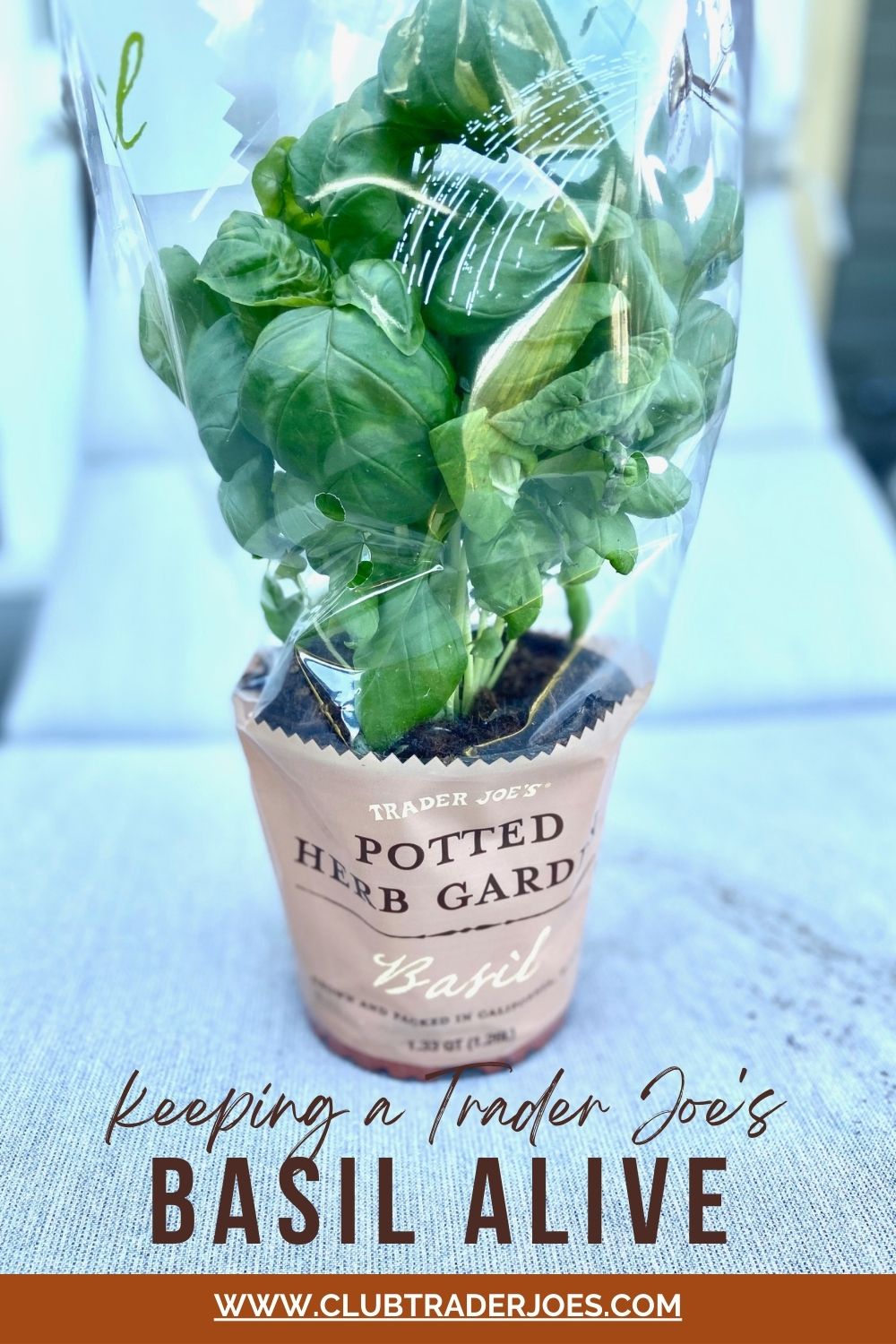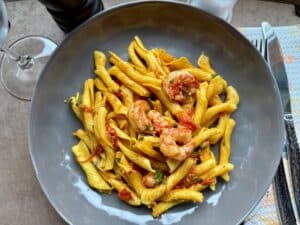
We’ve all seen the Trader Joe’s plants when you walk into the store. Trader Joe’s has done a great job of selling a wide variety of plants from indoor plants and succulents and cut flowers and to live herbs. One of the biggest perennial sellers in Trader Joe’s little plant department. Who hasn’t bought a basil plant and kept it on the kitchen counter for several months until all the leaves have been plucked from it? But what if you could keep one alive for many more months and keep picking basil for a much longer time?
Sure you go over the vegetable section and buy some of Trader Joe’s basil leaves in the clear plastic clamshell containers and just use it. It’s not a bad price (last time I looked it was around $4.99) and usually contains way more basil than you need for a recipe unless you are making a lot of pesto. I’ve even taken this harvested basil and snipped off the ends and stuck it in a jar of water. Basil is amazing in how fast it will root in water. You could even go as far as planting those in the soil and growing plants again. But it’s much easier to just buy a plant or two and keep them alive.
I usually buy about four plants in spring so I will have ample Basil throughout the summer.

Bringing Your Trader Joe’s Basil Plant Home
Trader Joe’s Basil plants are rather fragile. I think this is because they were probably raised in a greenhouse and that actually makes them pretty soft and easy to bruise. Ideally, when they grow up outside they are subjected to wind and direct sunshine that makes them a little tougher. Having said that, just be as gentle as you can with the plants on the way home.
The first thing you want to do when you get home is take that plastic wrap off!
The plastic wrap is there to protect the plant during transportation. If it wasn’t there, the stems and leaves would get tangled up with other plants and snap off. If you don’t take it off, which I have done myself, you’ll end up with mildew and rot on the plant. Those plants need air circulation and the plastic wrap prevents that.

The second thing is to water it deeply.
I put my pot in a shallow bowl or tray and give it a good drink of water. Poor baby has a hard trip and is probably parched after such a long journey. Put a plate or saucer under it because the water will probably run through the holes in the bottom.
Indoors or Outdoors?
Once you get it home you have some decisions to make. Do you want to keep it indoors or outdoors? If you bought it in the wintertime, your choice is clear. Basil plants cannot handle cold temperatures. The first frost will zap them to the ground overnight. You need to keep it inside.
If you bought your plant in the spring or summer, you can put it outside, but there are some things you need to do to make sure it survives.
Minimum Effort Indoors
Let’s say you just want some fresh basil leaves for a few weeks. The simplest thing to do is just keep it in your kitchen under a bright light or window ledge and water it regularly. It will live for weeks or months this way but it’s not sustainable for very long. Plants like Basil need bright sunlight and real soil to thrive but having a plant on your countertop is cheaper than buying bags of fresh basil all the time. Why not?

The Soil
The substance in the pot may resemble dirt, but it’s actually coco coir. Derived from the recycled fibers of coconut husks, coco coir serves as an excellent soilless growing medium, though it requires regular fertilization to remain effective. It’s likely that the growers supplying Trader Joe’s enrich the plants with fertilizer during each watering and also add some to the coco coir before shipping to ensure the plants remain viable for some time. However, this initial fertilization will eventually deplete. To maintain the health of your plants, it’s advisable to use a high-quality organic liquid fertilizer. Additionally, to sustain your plants over time, you will need to transplant them eventually.

Transplanting
I’ve done two types of transplanting, into bigger pots or into the ground. Both work well and will keep your Basil going for many months.
Before you move your plant outside, it needs to spend several days outside in the shade, away from direct sunlight. This is called hardening off. This allows the plant to adapt to its new environment without stress. The worst case is that you move your plant from indoors to directly in the hot sunshine in the garden, the leaves will sunburn and fall off in a couple of days. Hardening off the plant will ensure that you don’t stress it out too much and it builds up protection from the direct sun.

The easiest of the options (between potting and in the ground) is to just put your plant in the ground in a garden bed. Simply dig a big hole, large enough to contain the current roots. Sprinkle some dried organic fertilizer and worm castings in the hole (I use Espoma Garden-tone) and flip your plant upside down and pull the pot off then insert the whole thing in the new hole. Cover the roots with soil and water deeply. Fertilize with a balanced liquid fertilizer every week or so. I use Agrothrive Organic General Purpose Vegetable liquid fertilizer for this purpose.
If you want to put it into a pot, find some high quality organic potting soil (I like Fox Farms potting soils), dry fertilizer, and worm castings (I use worm castings all the time, they work wonders for your plants).
Once you get your plant in the ground or a pot, water it well and make sure it stays watered. Outdoors, it should give you many months of production if you don’t pick it to death, which is something I have done.

Harvesting your Basil
When harvesting leaves from your plant, remember to carefully pinch off a portion of the stem above a junction where two small leaves are emerging on opposite sides. By doing so, these two leaves will develop into complete branches, effectively doubling the number of leaves available for future harvests.
To encourage continuous growth and expansion, it is advisable to periodically pinch off sections of your basil plant, even when you do not require the leaves immediately. This practice promotes branching and overall plant size. Furthermore, it helps delay the onset of the plant’s reproductive phase known as ‘bolting,’ characterized by flowering and seed production. Once a plant starts to flower, you can’t stop it, but that doesn’t mean you can’t get leaves from it for a few more weeks but eventually it will stop producing leaves and just die eventually. Basil is a tender plant and can’t take a frost so if you live in a northern climate, eventually it will die.
If you are a heavy Basil user, having more than one plant in your garden is a must. If you just want occasional basil then just one plant is probably good enough. Enjoy!



